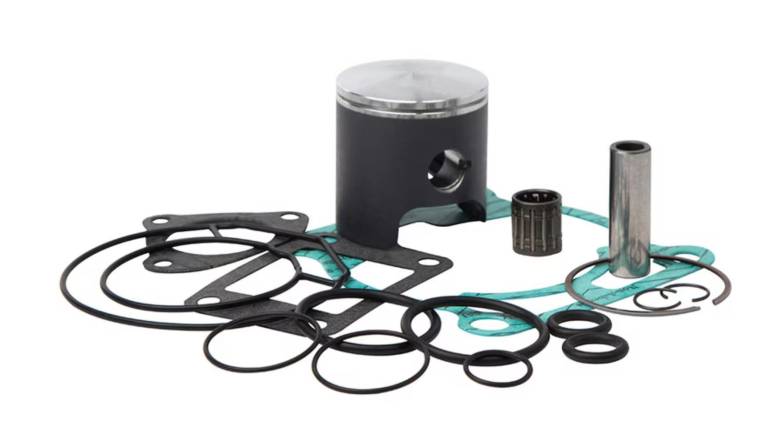Everything you need to know about Pistons! ... but were afraid to ask.
What size piston do I need?
If you are just replacing the piston, then you need to first know the bore of the cylinder. This can be done by using a bore gauge to find the diameter or by reading the owner’s manual to find the bore specifications. Ultimately, the bore should be measured for the best possible results. After the diameter is known, then you can pick which size piston will work best in your cylinder. Remember to maintain about a 0.05mm (0.002”) piston to cylinder clearance, depending on application. If you are having a cylinder re-plated, then you will want to choose a piston of the OE bore size (an A or B size is probably best). When you send the piston and cylinder away to get re-plated, the plating facility will match the cylinder bore to piston diameter. If you have a cast iron bore cylinder and you are sending the piston and cylinder off to a machinist to be bored out, then you will want a piston that is oversized from the current diameter. For example: If your current bore is 64.00mm, then you will want to choose a 64.50mm or similar oversized piston. The machinist boring the cylinder will bore and hone the cylinder to match the piston size.
Are Vertex pistons cast or forged?
Vertex pistons are both cast and forged. Vertex casts their two stroke pistons because of the ability to incorporate higher silicon content into castings as opposed to a forging. This gives the piston a lower thermal distortion characteristic and higher wear resistance. Vertex uses castings and forgings in its four stroke pistons depending on application. Low rpm, low performance four stroke engines can use cast pistons. High performance, high rpm engines (like today’s race bikes) use forged pistons for strength. Vertex has the ability to manufacture its pistons to suit each need.
Why does Vertex offer A, B, C, and D piston sizes and what is the difference between them?
Vertex offers A, B, C, D, sizes so that the customer can properly fit each piston to the cylinder. The difference in the sizes is 0.01mm (0.0004") increments with A being the smallest and D the biggest. When a cylinder wears, the customer can choose the next larger piston size to regain the proper factory fitment.

Which rings go where on a two stroke piston?
On a two stroke piston the rings are generally the same and it does not matter which ring groove they are installed in. However, some rings can be L shaped. If you have an L shaped piston ring, this one goes in the top ring groove. The most important thing to note on a two stroke is that if there are any letters stamped on the ring, by the ring gap, these letters face up. Some rings have a wedge shape and if these letters are not facing up, the ring will not fit all the way into the ring groove. It is also important to note that the rings compress properly into the ring groove of the piston and fit properly around the ring locating pin. And always remember to point the arrow on the piston dome towards the exhaust port.
2 Stroke Piston Kit
Which rings go where on a four stroke piston?
In four-stroke applications Vertex offers both two-ring and three-ring pistons. Three-ring pistons will have two compression rings and one oil ring. A two ring piston only has one compression ring and the oil ring. The oil ring on both types of pistons is a three piece design, consisting of two rail rings and one expander ring. On three-ring pistons, the two compression rings will go into the top two ring grooves and the oil ring will go in the bottom ring groove. The two compression rings may be different from each other. If this is the case then it is necessary to look at the profile of the rings to ensure they are located in the proper groove. Often one ring will have a taper to its profile. If this ring is installed into the wrong ring groove, it will not compress properly. It is also common for the second compression ring to be darker, because it may be made from cast iron. Ensure that any letters located at the tip of the rings are facing up. This is the same for two ring pistons except there is only one compression ring. When installing the oil ring, first install the expander ring and make sure the ends do not overlap. If you look closely at the expander ring, it has a shoulder/lip on both top and bottom that prevents the rail rings from seating completely against the piston groove. It is important that when installing the rail rings you do not allow them to sit on top of this should/lip. If the rail rings are not seated correctly on the expander rind then the oil ring will not fit in the groove properly. After all the rings are installed on the piston, make sure that each of the ring end gaps is about 120 degrees from each other.
What is the life of a two-stroke and four-stroke piston?
Piston life is relative to the operating conditions of the engine, so no exact life expectancy can be given. In a perfect world, about 20hrs is the max usage you want to try to get out of a piston. Again, this is all relative to use, maintenance, and operating conditions.
Select your make/model/year and scroll down to find your Vertex Piston Kits

SUBSCRIBE
By signing up the our newsletter you agree to your details being shared with mailchimp, who are the provider we use to send our newsletter. Please see our privacy policy for full details on how we manage your data.










